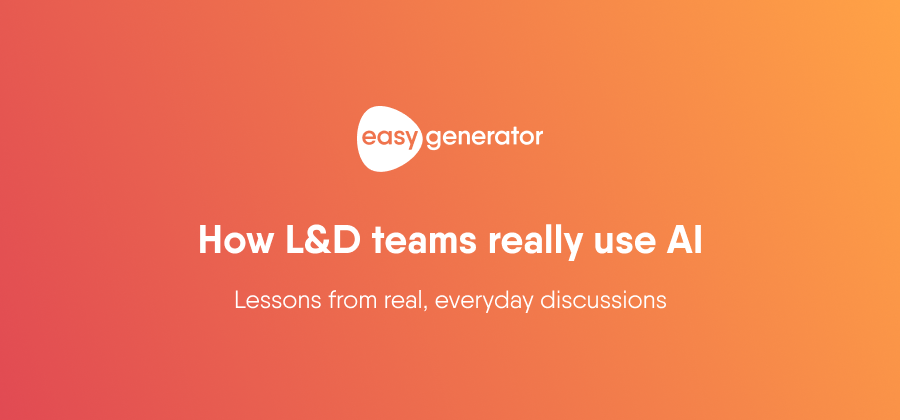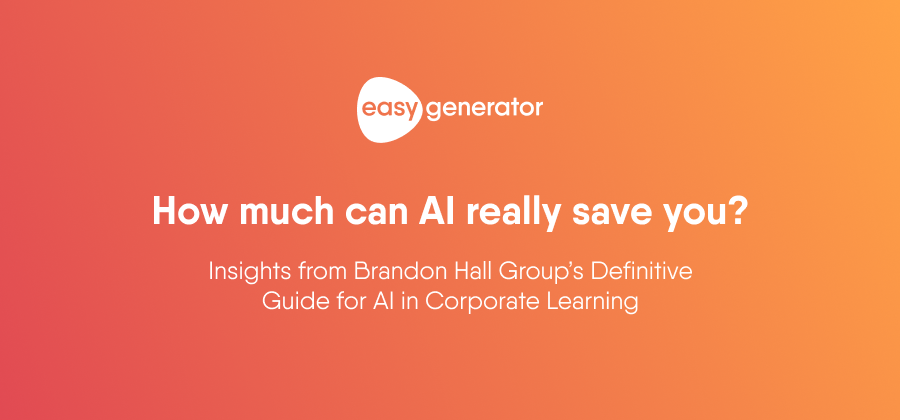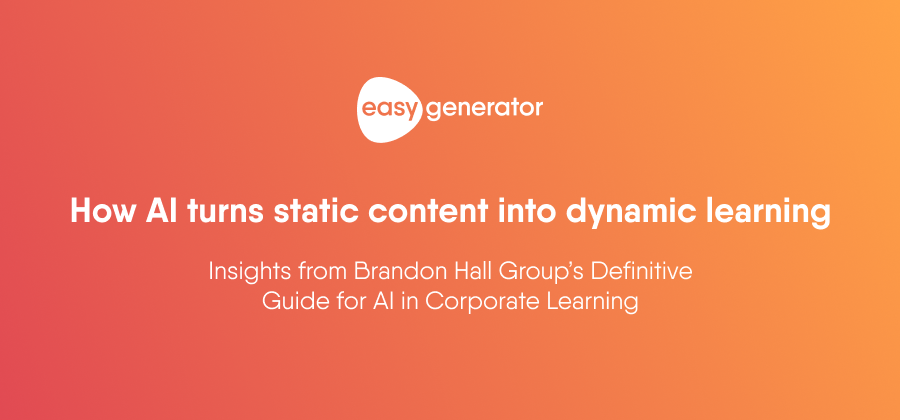Corporate e-learning: 5 trends shaping workplace training
Corporate e-learning is evolving, and companies must adapt. These five trends are transforming workplace training to be more engaging, skill-focused, and effective.

Corporate e-learning is evolving fast. Companies are shifting away from traditional training models, like long classroom sessions and one-size-fits-all courses, to more flexible, employee-driven, and data-powered learning experiences.
One of the biggest drivers of this change is AI and automation. As technology takes over repetitive tasks, employees need to develop new skills that AI can’t replace, like critical thinking, leadership, and problem-solving. This shift makes upskilling more important than ever, and L&D teams must rethink how they approach workplace training.
In this article, we’ll explore five key trends shaping the future of corporate e-learning and how companies can use them to improve workplace training.
1. Employee-generated Learning: the rise of peer-led training
Traditional corporate training was led by L&D teams and external trainers. However, companies are now shifting to Employee-generated Learning (EGL), where employees create and share knowledge with their peers instead of relying solely on formal training programs.
Why is this shift happening?
L&D teams don’t have the time or resources to develop every course employees need. Employees, on the other hand, have first-hand knowledge of their jobs and can create more relevant, real-world training for their colleagues.
The business benefits of Employee-generated Learning
- Faster course development: employees can create and share knowledge instantly, rather than waiting for L&D teams to design formal training.
- More relevant training: courses are based on real workplace challenges, making the learning experience practical and effective.
- Higher engagement: people are more likely to engage with training created by their peers.
How STADA scaled training with Employee-generated Learning
STADA, a global healthcare company, faced challenges with scattered training and knowledge loss. Employees relied on PowerPoint presentations, and there was no system to capture and scale knowledge across the organization.
To solve this, STADA introduced Easygenerator, enabling employees to create and share training content themselves. Since then, employees have developed over 1,700 courses, improving knowledge retention and making learning accessible across 45 countries.
Takeaway
Custom corporate e-learning platforms now allow employees to create structured, engaging training without instructional design experience. This makes EGL a scalable and effective training model.
2. From theory to skills: skill-based training
One of the biggest corporate e-learning trends is the shift from theoretical learning to practical, skill-based training. Employees don’t just want to learn concepts; they need job-specific skills that help them perform better. This shift is being driven by:
- Changing job roles: the skills required in many industries are evolving rapidly. Employees must upskill continuously to keep up.
- A results-driven workforce: employees expect training that translates into job performance, not just theoretical knowledge.
- The skills gap challenge: many companies struggle to fill positions due to a lack of qualified talent. Skill-based learning helps bridge this gap by developing employees internally.
How L&D teams are adapting
L&D professionals are no longer just content creators. They’re now facilitators of skill-building programs. Instead of spending months designing courses, they focus on:
- Helping employees find the right learning resources: whether through online courses, peer-led training, or hands-on experience.
- Supporting on-the-job learning: encouraging real-world application of knowledge rather than just classroom-style training.
- Measuring performance outcomes: tracking how training impacts employees’ daily tasks and business results.
Takeaway
Modern corporate e-learning platforms support skills tracking, assessments, and certification programs to help L&D teams focus on outcomes, not just content delivery.
3. Upskilling employees: preparing the workforce for the future
As technology advances, job roles are changing faster than ever. Automation and AI are reshaping industries, making some tasks obsolete while creating demand for new skills. This means companies can no longer rely on traditional training methods. They must invest in upskilling to prepare employees for the future.
For Learning & Development (L&D) teams, this shift is both a challenge and an opportunity. Instead of focusing solely on current job training, L&D must help employees develop new skills that will keep them relevant in a rapidly evolving workplace.
Why upskilling is critical now
The demand for upskilling is being driven by several key factors:
- AI and automation replacing repetitive tasks: employees need new skills to move into higher-value roles that require critical thinking, creativity, and problem-solving.
- The skills gap is growing: many organizations struggle to find employees with the right expertise. Upskilling helps fill internal talent gaps instead of hiring externally.
- Job roles are evolving faster than ever: skills that were relevant a few years ago may no longer be enough. Companies need continuous learning to keep up.
What skills should companies focus on?
While technical skills are important, soft skills and strategic thinking will be the most valuable in a world where AI can automate routine tasks. Key upskilling areas include:
- Critical thinking and problem-solving: AI can process data, but humans are needed to analyze, interpret, and make strategic decisions.
- Leadership and communication: as AI handles repetitive tasks, more employees will transition into management and decision-making roles.
- Creativity and innovation: employees will need to think outside the box to develop solutions AI cannot generate.
Takeaway
Upskilling is no longer optional. It’s essential for businesses to stay ahead. With AI automating routine tasks, employees must focus on high-value, strategic skills that will drive business growth.
4. Microlearning: training that fits the modern workday
Employees today are busier than ever. They don’t have hours to sit through lengthy training sessions. That’s why microlearning (short, focused learning modules) has become one of the fastest-growing corporate e-learning trends.
Microlearning delivers bite-sized training content that focuses on a single concept or skill. Instead of a 60-minute course, learners engage with 5- to 10-minute lessons that they can complete quickly and apply immediately.
Why microlearning works
- Better knowledge retention: research shows that breaking information into small, digestible chunks improves memory and recall.
- Higher engagement: employees prefer short, focused training over long, text-heavy courses.
- Fits into the workday: microlearning allows employees to learn on demand without disrupting their workflow.
- Encourages continuous learning: instead of taking one long course, employees can complete small lessons over time, reinforcing learning in the long run.
Popular microlearning formats
- Short videos: quick explainer videos on key concepts.
- Step-by-step guides: simple, structured walkthroughs for tasks.
- Interactive scenarios: decision-based learning to apply skills in real-world situations.
Takeaway
AI-powered corporate e-learning development supports personalized microlearning experiences based on job roles and skill gaps, making training more effective and accessible.
5. Gamification in e-learning: making training engaging
One of the biggest challenges in corporate e-learning is keeping employees engaged. Many learners struggle to stay focused during traditional training programs, leading to low completion rates and poor knowledge retention.
Gamification is changing that. By applying game-like elements to learning, companies can make training more interactive, rewarding, and motivating, leading to better engagement and improved learning outcomes.
Why gamification works in corporate e-learning
Gamification taps into basic human psychology. When employees receive instant feedback, challenges, and rewards, they are more likely to stay engaged and complete training.
Here’s why gamification is so effective:
- Boosts motivation: game-like elements make learning more exciting than reading long text-based modules.
- Encourages participation: employees feel a sense of progress and achievement when training includes challenges and rewards.
- Improves knowledge retention: learners remember content better when training is interactive and immersive.
- Creates a sense of competition: leaderboards and challenges encourage employees to push themselves further.
Essential gamification elements
- Quizzes: reinforce learning with multiple-choice, drag-and-drop, and fill-in-the-blank questions.
- Card sorting: help learners organize key concepts for better recall.
- Flip cards: provide interactive learning with questions on one side and answers on the other.
- Hotspots on images: allow learners to explore details by clicking on different areas of an image.
- Progress tracking and badges: give employees a sense of achievement.
Takeaway
Corporate e-learning platforms now include built-in gamification tools to increase completion rates and improve learning outcomes.
Easygenerator: the future-ready corporate e-learning solution
Each of these trends is shaping the future of workplace training. But how can companies implement them effectively?
Easygenerator provides a complete corporate e-learning solution, allowing businesses to:
- Enable Employee-generated Learning: employees can create training content without instructional design skills.
- Deliver skill-based training: track employee skills and ensure learning is job-relevant.
- Upskill employees for the future: help employees develop critical thinking, leadership, and digital skills to stay competitive as AI and automation reshape job roles.
- Support microlearning: build short, engaging modules that fit into employees’ busy schedules.
- Use gamification: add quizzes, interactive elements, and progress tracking to boost engagement.
Want to see how Easygenerator can transform your company’s training? Try 14 days for free.
-
 14 day trial with access to all features. Start with variety of course templates.
14 day trial with access to all features. Start with variety of course templates. -
 Get unlimited design inspirations. Level up your courses.
Get unlimited design inspirations. Level up your courses. -
 Upload your PowerPoint presentations. Get instant courses created.
Upload your PowerPoint presentations. Get instant courses created.





